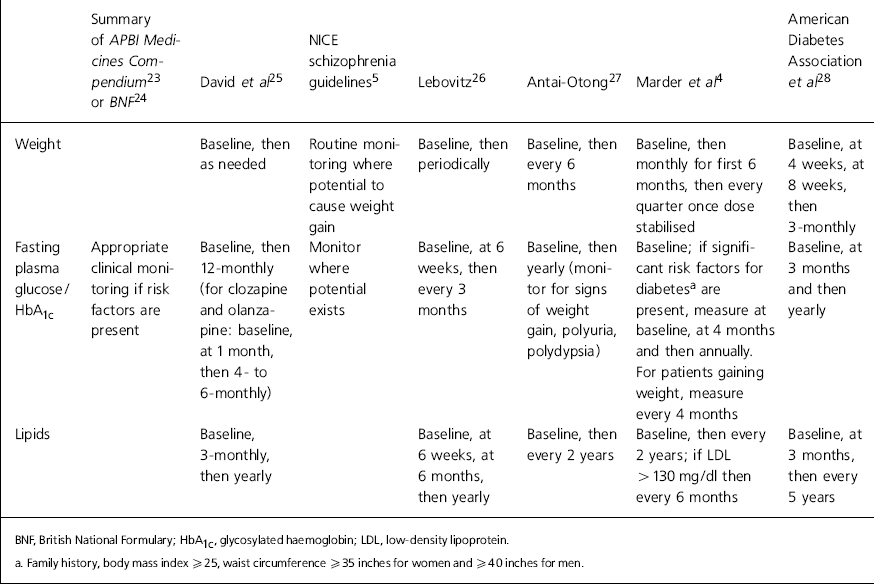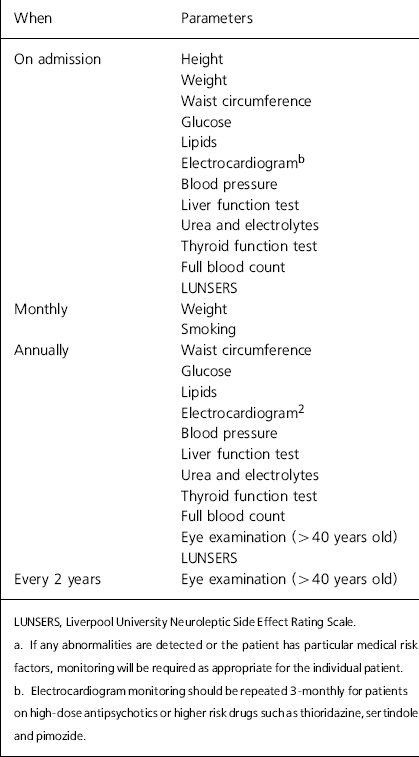There is now extensive evidence that people with severe mental illness have higher rates of morbidity and mortality for common physical illnesses than the general population. Reference Cohen and Hove1 However, in forensic settings there is a dearth of data on morbidity rates, but the limited evidence available does suggest significant rates of physical health problems for in-patients in secure settings. Reference Sebastian and Beer2,Reference Thomson, Bogue, Humphreys, Owens and Johnstone3
A number of publications have highlighted the need for physical health monitoring in individuals with mental health problems. Reference Marder, Essock, Miller, Buchanan, Casey and Davis4 Despite that, there is no established national consensus detailing precisely what should be measured and how frequently.
We are based in a forensic mental health service without any general practitioner input; patients can be resident for periods beyond 10 years. Primary care services are provided by psychiatric trainees and staff grade doctors.
The National Institute for Health and Clinical Excellence (NICE) guidelines on schizophrenia refer to primary and secondary services with regard to the provision of care to individuals with schizophrenia. 5 Criterion 12 of the guidelines highlights a minimum standard of physical health checks ‘at regular intervals’ for those with schizophrenia within primary care. We carried out an audit of this criterion within our in-patient service that demonstrated deficits in the measurement and recording of physical health parameters. Reference Gough, Churchward, Dorkins, Fee, Oxborrow and Parker6 The need for a more systematic approach to the execution and documentation of physical health checks has been highlighted by our audit and by other services. Reference Singh, Ahmed and Shaffiullha7 This paper addresses this need.
There is increasing evidence of the link between antipsychotic medication and physical health risks, such as:
-
• weight gain Reference Zhang, Yao, Liu, Fang and Reynolds8
-
• metabolic syndrome Reference McCreadie9,Reference Thakore10
-
• endocrine problems (e.g. diabetes, Reference Haddad11,Reference Lambert and Chapman12 hyperprolactinaemia, Reference Petty13,Reference Holt14 sexual dysfunction Reference Berner, Hagen and Kriston15 )
-
• cardiovascular problems
-
• sudden death Reference Herxheimer and Healy16,Reference Ray and Meador17
-
• abnormalities of QTc Reference Abdelmawla and Mitchell18
-
• effects on blood pressure Reference Haddad and Sharma19
-
• stroke. Reference Gill, Rochon, Herrmann, Philip, Sykora and Gunraj20
In the light of a high percentage (87%) of our in-patients being prescribed antipsychotic medication (Churchward et al, 2007 internal audit, Langdon Hospital, personal communication) and the potentially elevated risks in this group, we decided to set standards for physical health checks that would incorporate the risks associated with the institution and ongoing treatment with antipsychotics.
Method
A multidisciplinary group was formed in June 2006, comprising a senior mental health pharmacist (S.C.) and three staff psychiatrists (D.T., V.O., S.O.).
A widespread search of the English language publications to date was carried out to establish the relevant evidence base. The relevant papers were then reviewed and the key points summarised with respect to the physical health parameters that had been identified as important. A pragmatic consensus was agreed on by the group with regard to the parameters of what should be measured and how often.
Once standards had been agreed, other colleagues on site, from a variety of disciplines, were consulted to determine the most appropriate format for the implementation of the standards. We explored the current development of the NHS Care Records Service (NCRS), particularly the electronic patient records service, both locally and nationally. 21 Although the NCRS has the potential to include monitoring, we found that in its current state of development it does not have the flexibility to incorporate this type of tailor made monitoring. Reference Brennan22
An example of the summary of the key points from the review is presented in Table 1 (full review of recommendations on all parameters available from the authors on request).
Table 1. Comparison of recommendations for physical health monitoring in patients treated with antipsychotic medication (example)

| Summary of APBI Medicines Compendium 23 or BNF 24 | David et al Reference David, Paton and Kerwin25 | NICE schizophrenia guidelines 5 | Lebovitz Reference Lebovitz26 | Antai-Otong Reference Antai-Otong27 | Marder et al Reference Marder, Essock, Miller, Buchanan, Casey and Davis4 | American Diabetes Association et al 28 | |
|---|---|---|---|---|---|---|---|
| Weight | Baseline, then as needed | Routine monitoring where potential to cause weight gain | Baseline, then periodically | Baseline, then every 6 months | Baseline, then monthly for first 6 months, then every quarter once dose stabilised | Baseline, at 4 weeks, at 8 weeks, then 3-monthly | |
| Fasting plasma glucose/HbA1c | Appropriate clinical monitoring if risk factors are present | Baseline, then 12-monthly (for clozapine and olanzapine: baseline, at 1 month, then 4- to 6-monthly) | Monitor where potential exists | Baseline, at 6 weeks, then every 3 months | Baseline, then yearly (monitor for signs of weight gain, polyuria, polydypsia) | Baseline; if significant risk factors for diabetesa are present, measure at baseline, at 4 months and then annually. For patients gaining weight, measure every 4 months | Baseline, at 3 months and then yearly |
| Lipids | Baseline, 3-monthly, then yearly | Baseline, at 6 weeks, at 6 months, then yearly | Baseline, then every 2 years | Baseline, then every 2 years; if LDL > 130 mg/dl then every 6 months | Baseline, at 3 months, then every 5 years |
Results
Having collated the data, it was evident that there was a lack of uniformity from the different sources on how often the parameters should be measured (Table 1). A major obstacle to improving the quality of physical healthcare monitoring for patients with schizophrenia is the lack of consensus regarding which health parameters should be monitored and when they should be monitored. Reference Marder, Essock, Miller, Buchanan, Casey and Davis4
We recognise the importance of good primary care services for patients in forensic mental health services. However, this project did not attempt to incorporate all aspects of preventative healthcare but focused specifically on monitoring elements of physical health risk compounded by treatment with antipsychotic medication.
Parameters measured
We reached a consensus on which parameters should be measured and how often, based on the evidence we collated (Table 2). Where the evidence from the literature suggested monitoring less frequently than our own clinical experience, we agreed a frequency that we felt was clinically appropriate for our patient group. In particular, the recommendations on how often to weigh patients were rather infrequent compared with our current clinical practice. Given the ease of monitoring this parameter and the importance of this risk factor for our patients, we reached a consensus to continue to monitor weight on a monthly basis.
Table 2. Monitoring schedule required for all patients on antipsychotic medicationa

| When | Parameters |
|---|---|
| On admission | Height |
| Weight | |
| Waist circumference | |
| Glucose | |
| Lipids | |
| Electrocardiogramb | |
| Blood pressure | |
| Liver function test | |
| Urea and electrolytes | |
| Thyroid function test | |
| Full blood count | |
| LUNSERS | |
| Monthly | Weight |
| Smoking | |
| Annually | Waist circumference |
| Glucose | |
| Lipids | |
| Electrocardiogram Reference Sebastian and Beer2 | |
| Blood pressure | |
| Liver function test | |
| Urea and electrolytes | |
| Thyroid function test | |
| Full blood count | |
| Eye examination (>40 years old) | |
| LUNSERS | |
| Every 2 years | Eye examination (>40 years old) |
Recommendations on some parameters such as electrocardiogram (ECG) varied considerably in the literature, ranging from monitoring ECG at baseline, Reference Abdelmawla and Mitchell18 after each dose escalation and 6-monthly monitoring, 29 to monitoring 6-monthly for higher risk drugs. Reference David, Paton and Kerwin25 We reached a consensus taking into consideration the recommendations available and our own clinical judgement. We already had a procedure in place for the monitoring of patients prescribed high-dose antipsychotics, based on the Royal College of Psychiatrists guidelines. 30 Patients prescribed above the British National Formulary maximum dosages of antipsychotics 24 are routinely monitored with an ECG every 3 months. A consensus was reached to do a baseline ECG for all patients on admission and to do ECG monitoring every 3 months for patients prescribed high-dose antipsychotics or those on higher risk antipsychotics (pimozide, sertindole). We acknowledged that there were other circumstances where repeat ECG may be necessary, such as in patients with cardiovascular disease or following rapid tranquillisation, but felt that this was beyond the scope of our standards and that such cases would need appropriate individual care planning.
Regarding hyperprolactinaemia, the literature does not indicate a consensus on routine or even baseline monitoring of prolactin levels. Regular monitoring for signs of prolactin elevation or sexual dysfunction is, however, recommended. Reference Marder, Essock, Miller, Buchanan, Casey and Davis4,Reference Maguire31 The clinical consequences of hyperprolactinaemia include menstrual disturbance, galactorrhoea and sexual dysfunction. These clinical features are incorporated within the Liverpool University Neuroleptic Side Effect Rating Scale (LUNSERS). Reference Day, Wood, Dewey and Bentall32
Some side-effects of antipsychotics may be rare but are still significant to the patient such as the risk of cataract with phenothiazines and quetiapine. Reference Marder, Essock, Miller, Buchanan, Casey and Davis4 We therefore agreed to incorporate regular eye checks in our local standard for physical health checks in patients on antipsychotics.
We decided to include smoking in our final monitoring form as it is such an important lifestyle factor known to have impact on the risks that we are addressing in this paper.
We were keen to transform Table 2 into a format that would be more practical at the ward level and serve to prompt clinicians as to when monitoring was due. Consequently, we developed the physical health monitoring form (see online supplement to this paper).
Two other forms were devised (available from the authors on request) for annual monitoring of haematological and biochemical parameters as well as further monitoring of any abnormal result findings, but for the purpose of this paper we limited ourselves to the first year of antipsychotic administration.
Implementation
Our results were presented to the forensic multidisciplinary clinical governance meeting. Agreement was reached to incorporate the standards in a policy and procedure. Each patient would have a physical health form filed in a separate physical health folder, which could be checked at every clinical review meeting. Nursing staff and medical staff shared responsibility for collecting and recording data.
Discussion
The importance of monitoring physical health in all patients with mental health problems is apparent from current evidence. In population terms, the impact of treatment with antipsychotic medication is potentially compounding an already elevated risk of cardiovascular and metabolic disease in this patient group.
The lack of clear guidelines on how to implement NICE guidance is well known. Reference Rowlands33 We took a pragmatic approach using a consensus agreement between colleagues to create standards that we then implemented through the creation of structured monitoring forms, which can be translated into a computer-based system when available.
We hope that others may find this a useful model that could be applicable with modification in other settings.
Future areas of work could include development of algorithms for the management of abnormal findings (e.g. elevated blood sugar, hyperlipidaemia), exploration of patients’ perspective on monitoring of physical health, and re-auditing of completed physical health monitoring using the new standards and recording sheets.
We would like to see clear standards for physical healthcare and a structured monitoring system included in the NCRS.
Declaration of interest
None.





eLetters
No eLetters have been published for this article.